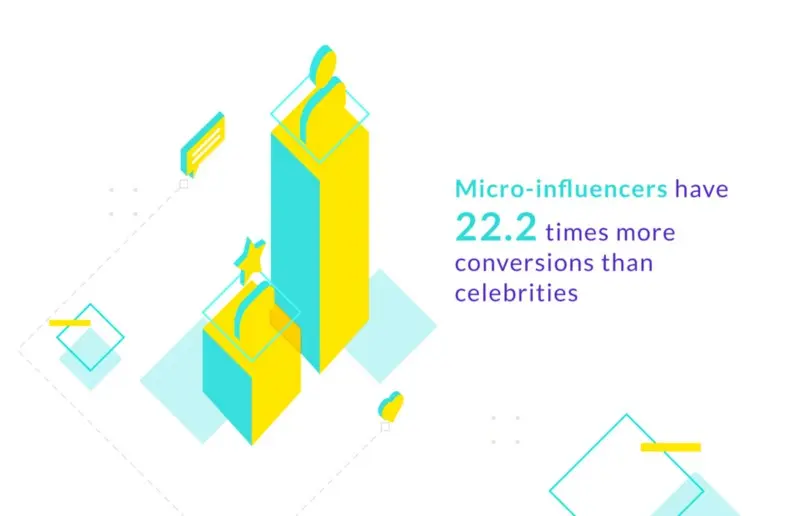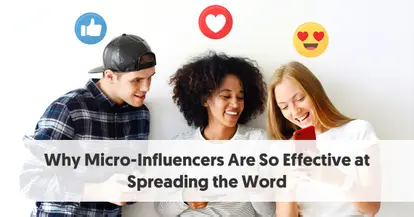If you have been a regular reader of the Influencer Marketing Hub, you will have noticed that we have regularly extolled the virtues of working with micro-influencers. Indeed, we have seen that the growth in interest in working with micro-influencers matches the increase in influencer marketing itself. According to our Monthly Influencer Marketing Report, 43% of marketers preferring micro and nano influencers, and 24.9% have shifted their budgets away from macro and mega influencers.
While the mainstream media seems fascinated by mega-influencers such as Kim Kardashian, the reality is that few brands can afford to work with such superstars. Indeed, Ms. Kardashian still wouldn’t be the best choice for the bulk of businesses, regardless of their influencer marketing budget.
Why? Well, the reality is that influencer marketing involving micro-influencers is far more successful for most businesses than campaigns using mega-influencers and celebrities. And the return on investment can be substantially better for a firm working with a series of micro-influencers.
Why Micro-Influencers Are So Effective at Spreading the Word:
What is a Micro-Influencer?
Unfortunately, there is no exact definition of a micro-influencer. In simple terms, a micro-influencer is somebody with a reasonable online following on a particular social media channel who has developed a reputation for having a focused passion in some niche or topic of expertise. Different sources, however, have differing views on what represents a “reasonable” following.
On the one hand, a micro-influencer's audience isn’t huge. If it were, the influencer would be a macro-influencer, or even a mega-influencer if their following is in the millions. On the other hand, their audience isn't tiny either. If they were, they would either be considered a nano-influencer (or too small to influence anybody).
If we look at other websites, we can begin to build a picture of the sort of followings typical of a micro-influencer. These include:
- Scrunch defines micro-influencers as having an audience within the follower range of 2,000 followers up until about 50,000 followers
- Hubspot considers micro-influencers to be in a narrower range: between 1,000 and 10,000 followers on social media
- Buffer goes one step further and considers them influencers with 10,000 or fewer followers, totally ignoring the existence of nano-influencers
- Shane Barker put together a comprehensive “gigographic” on The Ultimate Guide to Micro-influencers. In this, he states that micro-influencers have between 1,000 and 100,000 followers.
- Brand24 argues that “micro-influence is not defined by the number of one’s social following but the relevant conversation groups that a buyer engages in. Therefore, a micro-influencer is not someone with a specific number of followers – engaged or otherwise – but the people whom your potential buyer speaks with when considering a purchase decision.”
The concept of the nano-influencer is probably newer than many of these articles, so it is perhaps fair to consider a micro-influencer as anybody considered an expert in a niche, with between 1,000 and 50-100,000 followers.
Why are Micro-Influencers So Effective?
-
High Engagement Rates
There have been numerous studies over the last few years that show that micro-influencers are the sweet spot for influencer marketing. They generally have far better engagement rates than their larger, more famous counterparts. They have not yet grown to the point where they need assistance to run their social accounts and can keep things far more personal.
We recently analyzed 100,000+ influencer profiles across leading influencer marketing platforms, Instagram, TikTok, and Twitter, to see if there were variations in the engagement rate depending on an influencer's number of followers. We found quite a clear trend across all three platforms. Accounts with fewer followers consistently have higher engagement rates than accounts with large amounts of followers.
The typical celebrity or mega-influencer has millions of followers. There is no way that they can keep tabs on how their followers react to their posts. Indeed, in the case of celebrities, they may have little interest in their online accounts at all. Their focus is on whatever has made them famous: music, acting, sports, or the like. Many of their followers only follow them because they recognize the name, not because they are generally interested in the celebrity's posts.
Micro-influencers have the time to interact with their followers more often. They also have an online topic of expertise, so they regularly post and comment on that topic. Many of their followers have a keen interest in that subject and keep the conversations going.
If you work with a micro-influencer to promote your product (and it relates to their topic of expertise), then the micro-influencer is far more likely to carry on conversations with their followers about your product. They are probably more willing and able to answer questions concerning it too. The micro-influencers can more easily empathize with their audience and understand their pain points. They should be able to explain how your product can help solve these problems.
Micro-influencers are far more likely to be genuine advocates for your product, and not just somebody promoting it for the money.
-
More Affordable Than the Famous Names
Although micro-influencers are highly knowledgeable about a particular topic, they are still relatively ordinary people. This means that brands are far more likely to come to some arrangement with them at a relatively affordable price.
Macro and mega-influencers, however, are far more likely to charge considerable sums for any posts they make. Kim Kardashian, for instance, can command $500,000 for a single sponsored Instagram post. Sure, micro-influencers have a much smaller reach than Ms. Kardashian, but you would be able to contract many micro-influencers for $500,000.
Unless you are a large business with a sizable marketing budget, it makes sense that you work with a series of micro-influencers, rather than committing a large sum to a more significant influencer.
-
Work in Niche Markets
Both micro- and nano-influencers have a real part to play in promoting niche and specialist products. There would be little point working with a larger influencer because the vast bulk of his or her followers would have little interest in your niche product.
You wouldn't expect a celebrity to promote specialist products that appeal to only a small group of people (unless they had a personal interest in the product). The same applies to mega- and macro-influencers. Their following covers too broad a cross-section of society.
You will find smaller influencers who specialize in virtually every imaginable niche, however.
If you plan to work with a series of micro-influencers, look for those who would interest your ideal customer. In particular, you will want to think about the common interests of the types of people who buy your product and search for compatible micro-influencers.
-
Have High Conversion Rates
If we go back to the definition of a micro-influencer, we see that they are relatively ordinary people who have a passion for one specialist topic. This gives them high authenticity. People see them as being like themselves, but very knowledgeable about something. People place a high level of trust in micro-influencers. They take real notice of their reviews and recommendations.
This is no different in the business world. Even if you operate in the B2B sector, you will seek out reviews of products before you commit the company’s money. When you go online, you might first check out a site's case studies and look at review sites to see what others think.
This means that micro-influencers have a disproportionate effect on people's buying decisions, and any positive reviews or recommendations they make can be of real value.

Image Source: https://influenceye.com/
-
There Are a Huge Pool of Micro-Influencers
One real advantage of working with micro-influencers is that there are so many of them from which you can choose. You won't have to fight your competitors for a few superstars, which you might have to do if you focused on mega- or macro-influencers.
No matter what you sell, you should be able to find micro-influencers who have built reasonably sized audiences, and who will be willing to build a relationship with you.
Niches Where Micro-Influencers Can be Effective
In simple terms, micro-influencers can be useful to firms in most sectors. However, you can probably narrow things down to some extent. You have to look closely at the habits and interests of your potential customer base.
The first requirement for influencer marketing (in any form) to be viable is that your typical customers spend time on social media, or at least read blogs or watch YouTube-type videos. If you sell to people who rarely venture online, then you would do better, shifting your marketing budget elsewhere.
You will find many micro-influencers in niches such as fashion, beauty, travel, lifestyle, lifestyle, and technology. You can also add entertainment to this list. However, some forms of entertainment interest a broader, more general audience, who have a greater interest in the posts of celebrities and more significant influencers. One way around this is to look at the niche platforms. For instance, if you sell to gamers, you will find many micro-influencers on specialist streaming platforms like Twitch and Mixer. If music is more relevant to your product, then you might look at TikTok as a place to find relevant micro-influencers.
How to Go About Finding Suitable Micro-Influencers
There are three main ways you can go about finding influencers :
- You can work with a specialist influencer agency who will help find suitable micro-influencers to meet your needs
- You subscribe to one of the influencer marketing platforms that specialize in influencer discovery
- You go through the organic process of finding influencers and gradually build up relationships with potential micro-influencers. Ways you can do this include:
- Finding micro-influencer fans from your existing follower lists
- Searching for micro-influencers using relevant hashtags
- Researching the top accounts in your niche (and ignoring those with more than 50 to 100,000 followers)
- Using Google search to find the top bloggers in your niche
- Using YouTube search to find the top video channels in your niche
If you opt to use one of the influencer platforms, you will generally have the chance to do a highly detailed demographic search for potential micro-influencers. You will want to first focus on the niche they tend to make posts in most often, and then the demographics of their followers. Try and build up a picture of the typical users of your product or service, focusing on demographics like age, location, gender, occupation, and interests.
Once you have a list of potential micro-influencers, take a look at the typical kinds of posts they make. Are they relevant to your needs? Does the micro-influencer engage meaningfully with his or her audience?
From this research, you should be able to put together a shortlist of potential micro-influencers to approach with the suggestion of forming a partnership.





